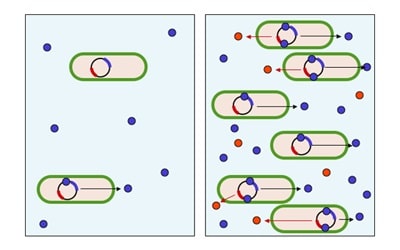It’s a familiar story – molecular biology meets protein science, they get closer and sparks fly. But how exactly does a proximity ligation assay (PLA) work and how do you make sure yours will have a happy ending?
What PLA Does
PLA allows you to detect individual proteins or individual protein interactor pairs without ectopic overexpression. It can provide information on the location and concentration of your target proteins. And it can be used to detect post-translational modifications of proteins.
How PLA Works
Put simply, PLA is the conversion of protein recognition events into detectable DNA molecules. PLA works via the simultaneous and close binding of affinity probe pairs onto a target protein (that’s the protein science part) that results in an amplifiable detection signal in the form of a DNA hybrid product (and that’s the molecular biology part). Sound good so far? Let’s break down the steps.
The Method
1. Get Your Sample
You can perform PLA on many different samples including protein suspensions (e.g. cell lysates, conditioned media, blood serum or plasma) or fixed tissues (e.g. cell culture slides, cytospin preparations or tissue sections).
Enjoying this article? Get hard-won lab wisdom like this delivered to your inbox 3x a week.

Join over 65,000 fellow researchers saving time, reducing stress, and seeing their experiments succeed. Unsubscribe anytime.
Next issue goes out tomorrow; don’t miss it.
2. Add Your Affinity Probes
The probes in a PLA experiment are usually either purified antibodies, or specially designed DNA aptamers that bind specifically to your protein(s) of interest. You will need either one polyclonal or two monoclonal affinity probes in each PLA experiment – in either case, the affinity probes are capable of binding at least two different sites. In a single protein detection PLA, the affinity probes will bind to different sites on the same protein; whereas in a two protein detection assay, the affinity probes will each bind specifically to one of your-proteins-of-interest. If you want to detect post-translational modifications, at least one of your affinity probes needs to be able to bind the modified protein.
3. Attach Ligation Arms
Ligation arms are short sequences of DNA attached to the affinity probes. Ligation arms can be directly attached to your affinity probe. But if they are not, you will need to indirectly attach them via a secondary antibody with the ligation arm conjugated. Expert tip: In every PLA there will be two ligation probes – one known as a “PLUS probe” and the other as a “MINUS probe” – including in experiments where there is only one polyclonal affinity probe. In this case, despite all of the affinity probes having the same specificity for your protein some of them need to have the “plus ligation arm” bound to them and others need to have the “minus ligation arm” bound to them, otherwise your experiment won’t work.
4. Add Connector Oligonucleotide & DNA Ligase
The connector oligo is a short sequence of DNA that hybridizes to the two ligation arms and guides their free ends together where they can ligate to each other (with the help of DNA ligase) to form a ligation product.
5. Amplify & Detect
Next you need to amplify your DNA ligation product and perform the detection step.There are three possible detection methods for PLA:
a. qPCR Detection
During a qPCR-based detection method, amplification and detection occurs simultaneously. In this method you just add standard qPCR reaction components (primers specific for your ligation hybrid product, DNA polymerase, dNTPs, reverse transcriptase, DNA dye, etc) to replicate your products for quantification.
b. Fluorescence or Brightfield Detection
In these methods the amplification and detection steps are performed separately for fluorescent probe detection. These methods rely on rolling circle amplification (RCA) of DNA. Instead of forming a linear ligation product as in qPCR, in RCA circular product is formed. More precisely one of the ligation arms serves as a primer for the RCA reaction while phi29 DNA polymerase replicates and unwinds the other ligation arm from the DNA circle. This generates a randomly coiled, single-stranded product composed of hundreds of copies of the DNA circle, covalently linked to one ligation arm. These DNA copies can then be detected through hybridisation of fluorescent- or enzyme-labelled oligonucleotides, which can be visualized with fluorescent or brightfield microscopy.
c. Blot Detection
This method involves the attachment of your separated proteins onto a solid-phase support (generally a PVDF membrane) by standard SDS-PAGE and Western blot methods, before subsequent PLA as described above from Step 2. Detection is then performed using RCA (see Step 5b) followed by hybridisation of an enzyme-, fluorescent-, or radio-labelled oligonucleotide complementary to the circular DNA sequence, and corresponding visualization method. See table 1 below for a summary of PLA method. [table id=16 /] How have you used PLA in your research? Do you have any tips and tricks to share that made you and your PLA live happily ever after?
You made it to the end—nice work! If you’re the kind of scientist who likes figuring things out without wasting half a day on trial and error, you’ll love our newsletter. Get 3 quick reads a week, packed with hard-won lab wisdom. Join FREE here.








